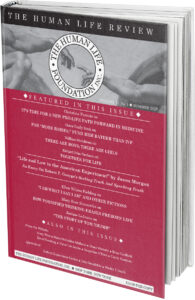Scrolling Along, Alone
The cultural and media critic Neil Postman (1931-2003) was a 20th-century prophet. His seminal work Amusing Ourselves to Death, published in 1985, may seem a bit quaint today in its railing against the evil effects of television on reading, culture, and the very shape and capacity of our minds. But the scrutiny he directed at the boob tube can now be applied to the internet and smartphone, and with a bitter twist. Rather than “amusing,” we are addicting ourselves, and our children, to death—staring at screens even more intensely than the TV generation did, and mostly alone.
Although fewer people watch TV these days than in his time, Postman’s analysis provides us with insight applicable to our growing fixation on smaller and more addictive screens. I am reading the 2005 “Twentieth Anniversary Edition” of the book, with an Introduction by Postman’s son Andrew (penned two decades after the book’s original release, an interesting read in itself.) While Andrew admits that some of his father’s points about TV may not directly apply to today’s media, he concludes: “His questions can be asked about all technologies and media. What happens to us when we become infatuated with and then seduced by them? Do they free us or imprison us? Do they improve or degrade democracy? Do they make our leaders more accountable or less so? Do they make us better citizens or better consumers? Are the trade-offs worth it?”
He then poses the most cogent question, which speaks to the current push to ban cellphones during school time and legally limit minors’ access to online content and social media: “If [the trade-offs are] not worth it, yet we still can’t stop ourselves from embracing the next new thing because that’s just how we’re wired, then what strategies can we devise to maintain control?”
In Amusing Ourselves to Death, Neil Postman identifies stages of public communication: First there was the preliterate eon of oral transmission, lost to history because there are no artifacts to study. When humans began to write down their thoughts, and keep records of their interactions, a new age dawned, which changed not only how people communicated but shaped the way they thought about the world and themselves. The next great stage came in the 1400s when the printing press ushered in a “typographic” mindset that Postman regards as the height of human social and intellectual development. He calls the time of print “sovereignty” the Age of Exposition, explaining that “Exposition is a mode of thought, a method of learning, and a means of expression. Almost all of the characteristics we associate with mature discourse were amplified by typography.” To further his point, Postman quotes the sociologist Lewis Mumford: “’More than any other device, the printed book released people from the domination of the immediate and the local; . . . print made a greater impression than actual events . . . To exist was to exist in print: the rest of the world tended gradually to become more shadowy. Learning became book learning.’”
[This calls to mind our current tendency to think that if you’re not on the internet, as a business or a personality, you really don’t exist.]
The post-typographic age of TV, Postman claims, which dominated the latter half of the 20th century, turned our minds from exposition to entertainment. As the eye is the window on the world, the mind is oriented toward images. But what happens when the mind is focused on images (accompanied by music and other sounds that please the ear) flashing on a screen in the little world of the living room –or bedroom or kitchen—TV rather than the real world outside the door? When sitcoms take the place of real situations, and news shows are dominated by stories “told” in images rather than exposition? Postman argues that we become conditioned to think in terms of sound bites, neat plot arcs, and show-and-tell simplicities that limit our capacity for intellectual engagement. In short, we choose entertainment over information and enlightenment.
As one who was born in the late 1950s—the Golden Age of TV—and remembers when my parents bought our first black-and-white TV with its rabbit-ear antennas, I can see Postman’s point. It has taken assuming a decidedly counterculture stance to keep myself and my children away from the pervasive reach of, first TV, and now the internet. The issue is serious, as the title of Postman’s book states —a life-and-death struggle, morally and intellectually. Digital addiction is the pervasive social danger of our times, as the rise in loneliness, depression, and obesity indicates. Although too many have surrendered to what they see as the inevitable, we can learn from Postman how to resist death by a thousand tweets: Open a book and start an exposition revolution in your home.










One of the most insightful articles on this age’s addictions that I have seen. BRAVO!